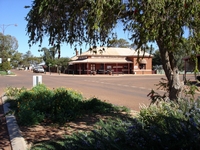Australia So Much to See


Setting the scene for a perfect murder.
An itinerant worker using the name Snowy Rowles and crime writer Arthur Upfield meet and discuss a method of disposal of a murder
victim’s body, a method that that Rowles was to use. The background to three murders and the transcript of this real life mystery
can be read in the Shire of Sandstone office.
The search for a plot
Back in 1929 Arthur Upfield, who had already written three novels, was working as a boundary rider on the
Rabbit Proof Fence in
He mentioned this difficulty
to a colleague, George Ritchie. Ritchie devised a disposal method: burn the victim's body, filter any bone fragments out of the ashes,
dissolve them in acid, pound any remaining solids into dust, then discard the remains into the wind. But Upfield had a problem: the
method was a bit too efficient, leaving the fictional detective of Upfield's novel no way to detect or prove the murder. Upfield challenged
Ritchie to find a flaw in the method and offered him £1 if he could. Ritchie, however, was unable to do so.
The plot of the novel
hinged on this point and Ritchie one day met Snowy Rowles, whom Upfield and Ritchie both knew. Ritchie mentioned the problem to him.
All of Upfield's friends and colleagues were soon aware of Upfield's difficulties with his plot.
On 5th October 1929, a
group of men consisting of Upfield, Ritchie, Rowles, the son of the Inspector of the fence, and the north boundary rider for the fence
were all present at the Camel Station homestead when the murder method for Upfield's book was again discussed. Upfield himself was
clear that Rowles knew of the disposal of a body method before this date, but the meeting and discussion was later used as evidence
in court to prove that Rowles was aware of this method.
James Ryan and George Lloyd disappear
In December 1929, Rowles was in the company of two men named James Ryan and George Lloyd.
On 8th December 1929, Rowles, Ryan and Lloyd departed from Camel Station. Several days later, George Ritchie arrived at Camel Station
and told Upfield that he'd met a prospector named James Yates. Yates mentioned to Ritchie that Rowles, Ryan and Lloyd had passed by.
Rowles had been driving a car and had told Yates that Ryan and Lloyd were walking through scrub, gathering timber. Neither Yates,
Ritchie nor Upfield saw anything odd in this behaviour; but Yates, significantly, had only seen Rowles. Rowles had told him that Ryan
and Lloyd were walking through the scrub but Yates did not see them himself. Lloyd and Ryan were never seen again.
On Christmas
Eve, 1929, Upfield was with a colleague in the small town of
Louis Carron disappears
A man named Louis Carron had arrived in the Murchison area in 1929, having come from
Investigations begin
Carron had kept regular correspondence with his friends and it was for this reason that his disappearance
was noticed. The area at the time had a large transient population, and for a man to appear or disappear from the area was in no way
remarkable. Indeed, it was not until police detectives started investigating Carron's disappearance that it was noticed that Lloyd
and Ryan were also missing, and had also last been seen in Rowles' company.
The attempts by Upfield to find a plot for his novel
The Sands of Windee were well known, and detectives were soon aware of the murder method outlined. They found the remains of Carron's
body at the 183-mile (295 kilometres) hut on the rabbit-proof fence. Among other items found were a wedding ring that would later
be positively linked to Carron by a
Arrest, trial and execution
A police officer, Detective-Sergeant Manning, was sent to arrest Rowles. When doing so, he immediately
recognised Rowles as a man named John Thomas Smith, wanted after escaping from Dalwallinu in 1928 after having been jailed for burglary.
Manning was able to send Rowles back to prison and thus had more time to complete his investigations.
Either from a lack of evidence
or from convention at the time, Rowles was only tried for the murder of Louis Carron. Like Rowles, Carron had assumed a new name,
previously having been known as Leslie George Brown. His wife, Mrs. Brown, had attended a jeweller in
Evidence was given about Rowles' behaviour and his knowledge of the fictional murder method.
Evidence was also presented to the court about various lies that Rowles had told about his movements. There was little doubt that
Rowles had committed three murders and the jury returned a guilty verdict in only two hours. Following two unsuccesful appeals, Rowles
was hanged for murder of Louis Carron on 13th June 1931.
Acknowledgements
Arthur Upfield continued to be a successful crime writer and his character Bony, an Aboriginal Detective, spawned
a television series.
In 2009, a tele-movie based on the Murchison Murders was broadcast on ABC television.
Above
sourced from Wikipedia - The Murchison Murders
Use your browser back button to return to the page you were reading
